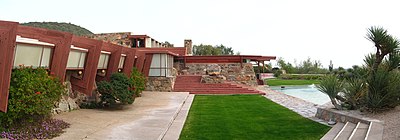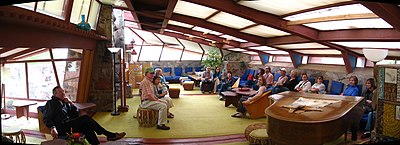Taliesin West
Taliesin West | |
 | |
| Location | Frank Lloyd Wright Boulevard, Scottsdale, Arizona, USA |
|---|---|
| Built | 1937 |
| Architect | Frank Lloyd Wright |
| NRHP reference No. | 74000457[1] |
| Significant dates | |
| Added to NRHP | February 12, 1974[2] |
| Designated NHL | May 20, 1982[3] |

Taliesin West was architect Frank Lloyd Wright's winter home and school in the desert from 1937 until his death in 1959 at the age of 91. Today it is the main campus of the Frank Lloyd Wright School of Architecture[5] and houses the Frank Lloyd Wright Foundation.
Open to the public for tours, Taliesin West is located on Frank Lloyd Wright Boulevard in Scottsdale, Arizona, USA. The complex drew its name from Wright's summer home, Taliesin, in Spring Green, Wisconsin.
History
Wright and the Taliesin Fellowship began to "trek" to Arizona each winter in 1933. In 1937 Wright purchased the plot of desert land that would soon become Taliesin West. He paid “$3.50 an acre on a southern slope of the McDowell Range overlooking Paradise Valley outside Scottsdale.”[6]
Wright believed this to be the perfect spot for such a building, a place of residence, a place of business and a place to learn. Wright described it like this, “Finally I learned of a site twenty-six miles from Phoenix, across the desert of the vast Paradise Valley. On up to a great mesa in the mountains. On the mesa just below McDowell Peak we stopped, turned, and looked around. The top of the world.”[7]
Being in the desert water could scarcely be found. This resulted in an investment of over ten thousand dollars to dig a well deep enough to provide sufficient water for the campus.
Design
Wright felt very strongly about the connection to the desert. He said: “Arizona needs its own architecture… Arizona’s long, low, sweeping lines, uptilting planes. Surface patterned after such abstraction in line and color as find “realism” in the patterns of the rattlesnake, the Gila monster, the chameleon, and the saguaro, cholla or staghorn – or is it the other way around—are inspiration enough.”
The structure's walls are made of local desert rocks, stacked within wood forms, filled with concrete. Wright always believed using the materials readily available opposed to those that must be transported to the site. In Wright’s own words, “There were simple characteristic silhouettes to go by, tremendous drifts and heaps of sunburned desert rocks were nearby to be used. We got it all together with the landscape…”[7] The flat surfaces of the rocks were placed outward facing and large boulders filled the interior space so concrete could be conserved.
Natural light also played a major part in the design. In the drafting room, Wright used translucent canvas to act as a roof (later replaced by plastic because of the intense wear from the Arizona sun). In the south-facing dining room, Wright did not take the masonry walls from floor to ceiling, and designed the roof to hangover passed the walls preventing unwanted sun rays from penetrating but allowing for horizontal light to pass through the room. Wright believed natural light aided the work environment he had his apprentices in keeping the inside of his building in touch with the natural surroundings.
Every part of Taliesin West bears Frank Lloyd Wright’s personal touch. Upon every return after a summer in Wisconsin Wright would grab a hammer and immediately make his way through the complex. He would walk through each room making changes or shouting orders to apprentices closely following with wheelbarrows and tools. He constantly changed and improved on his design fixing arising problems and addressing new situations. Throughout the years he added an addition to the dining room, the cabaret theatre, music pavilion and numerous other rooms. All of the furniture and decorations were designed by Wright and the majority built by apprentices. One of the most brilliant aspects of Wrights design is the cabaret theatre. Built with six sides, out of the standard rock, concrete mixture, in an irregularly hexagonal shape, the theatre provides its occupants with 95 percent acoustic perfection. One sitting in the back row can hear the lightest whisper from a speaker on stage.
Legacy
During his lifetime, Wright continually altered and added to the complex of buildings, all of which were constructed by students.
Many of Wright's most famous buildings were designed in the drafting room at Taliesin West, including the Guggenheim Museum in New York City and Grady Gammage Auditorium at Arizona State University in Tempe.
Taliesin West continues as the headquarters of The Frank Lloyd Wright Foundation and as the winter home for the School of Architecture. Restoration work to the private quarters of Mr. and Mrs. Wright was completed in 2004, and tours of the home and school are conducted on a regular basis.[8]
The structure was designated a National Historic Landmark in 1982.[3] [9] [10]
In 2008, the U.S. National Park Service submitted Taliesin West along with nine other Frank Lloyd Wright properties to a tentative list for World Heritage Status. The 10 sites have been submitted as one, total, site. The January 22, 2008 press release from the National Park Service website announcing the nominations states that, "The preparation of a Tentative List is a necessary first step in the process of nominating a site to the World Heritage List."[11]
Gallery





References
- ^ Red Book WriteupTemplate:NRIS dead link
- ^ "National Register Information System". National Register of Historic Places. National Park Service. January 23, 2007.
- ^ a b "Taliesin West". National Historic Landmark summary listing. National Park Service. Retrieved 2007-09-27.
- ^ NHL WriteupTemplate:NRIS dead link
- ^ Taliesin, the Frank Lloyd Wright School of Architecture | Campuses
- ^ Secrest, Meryle (1992). Frank Lloyd Wright. Alfred A Knopf. p. 451.
{{cite book}}: Cite has empty unknown parameter:|coauthors=(help) - ^ a b Wright, Frank Lloyd (1943). An Autobiography. Duell, Sloan and Pearce.
- ^ NHL Summary
- ^ "Taliesin West NHRP Nomination by James H. Charleton" (PDF). National Park Service. 1982.
- ^ "photos accompanying Taliesin West NHRP Nomination" (PDF). National Park Service. 1982.
- ^ New US World Heritage Tentative List
External links
- Taliesin West Official Site
- Frank Lloyd Wright Foundation established at Taliesin West
- The Frank Lloyd Wright School of Architecture, the official website of the school
- National Historic Landmarks Program - Taliesin West
- National Parks Service record, has a wonderful description of the site
- website with pictures of architecture.
- Taliesin West review by a+t architecture publishers
- Houses completed in 1937
- Houses on the National Register of Historic Places in Arizona
- Frank Lloyd Wright buildings
- National Historic Landmarks in Arizona
- Artist studios
- Historic house museums in Arizona
- Buildings and structures in Scottsdale, Arizona
- Museums in Scottsdale, Arizona
- Biographical museums in Arizona
- Architecture museums in the United States

